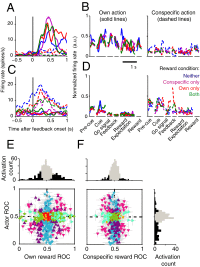Activity of striatal neurons reflects social action and own reward
- PMID: 24062436
- PMCID: PMC3799314
- DOI: 10.1073/pnas.1211342110
Activity of striatal neurons reflects social action and own reward
Abstract
Social interactions provide agents with the opportunity to earn higher benefits than when acting alone and contribute to evolutionary stable strategies. A basic requirement for engaging in beneficial social interactions is to recognize the actor whose movement results in reward. Despite the recent interest in the neural basis of social interactions, the neurophysiological mechanisms identifying the actor in social reward situations are unknown. A brain structure well suited for exploring this issue is the striatum, which plays a role in movement, reward, and goal-directed behavior. In humans, the striatum is involved in social processes related to reward inequity, donations to charity, and observational learning. We studied the neurophysiology of social action for reward in rhesus monkeys performing a reward-giving task. The behavioral data showed that the animals distinguished between their own and the conspecific's reward and knew which individual acted. Striatal neurons coded primarily own reward but rarely other's reward. Importantly, the activations occurred preferentially, and in approximately similar fractions, when either the own or the conspecific's action was followed by own reward. Other striatal neurons showed social action coding without reward. Some of the social action coding disappeared when the conspecific's role was simulated by a computer, confirming a social rather than observational relationship. These findings demonstrate a role of striatal neurons in identifying the social actor and own reward in a social setting. These processes may provide basic building blocks underlying the brain's function in social interactions.
Conflict of interest statement
The authors declare no conflict of interest.
Figures




References
Publication types
MeSH terms
Grants and funding
LinkOut - more resources
Full Text Sources
Other Literature Sources

